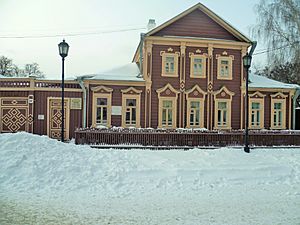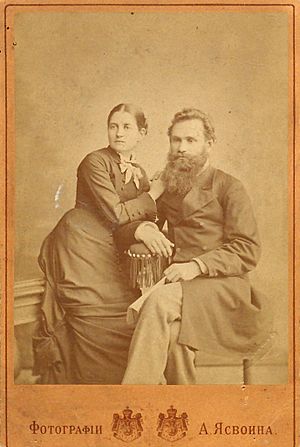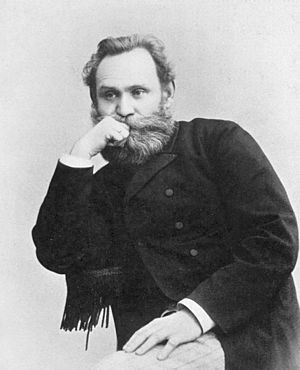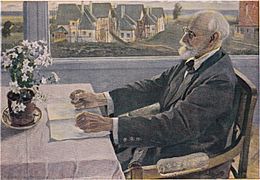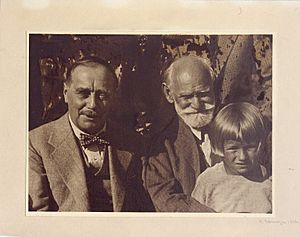Ivan Pavlov facts for kids
Quick facts for kids
Ivan Pavlov
|
|
|---|---|
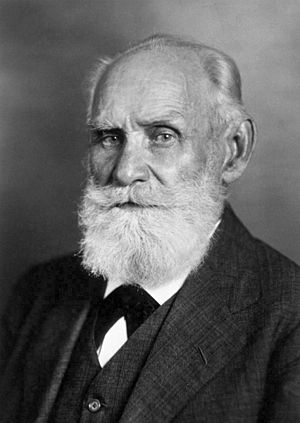 |
|
| Born | 26 September 1849 Ryazan, Russian Empire
|
| Died | 27 February 1936 (aged 86) |
| Alma mater | Saint Petersburg University |
| Known for |
|
| Spouse(s) |
Seraphima Vasilievna Karchevskaya
(m. 1881) |
| Children | 5 |
| Awards |
|
| Scientific career | |
| Fields | Physiology, psychology |
| Institutions | Imperial Military Medical Academy |
| Doctoral students | Pyotr Anokhin, Boris Babkin, Leon Orbeli |
| Influences |
|
| Influenced |
|
Ivan Petrovich Pavlov (born September 26, 1849 – died February 27, 1936) was a famous Russian scientist. He was a doctor who studied how the body works (a physiologist). Pavlov is best known for his discovery of "classical conditioning." This is a type of learning he found by doing experiments with dogs. His work greatly changed how we understand learning and behavior.
Contents
Pavlov's Early Life and Studies
Ivan Petrovich Pavlov was born in Ryazan, Russia. He was the first of eleven children. His father was a village priest, and his mother was a dedicated homemaker. As a child, Ivan helped with chores around the house. He loved gardening, riding his bicycle, and playing games.
When he was seven, Pavlov had a serious accident. He fell from a high wall and was badly hurt. Because of this, he did not start school until he was 11 years old. From a young age, Pavlov showed great curiosity. He called this his "instinct for research."
Inspired by new ideas about science, Pavlov decided to study science instead of becoming a priest. In 1870, he joined the University of Saint Petersburg. He studied natural science there. During his studies, his first research project was about the nerves of the pancreas. This work won him an important university award. In 1875, Pavlov finished his studies with excellent results. He then decided to continue learning about how the body works (physiology).
He later became an assistant at the Veterinary Institute. For two years, Pavlov studied the circulatory system. In 1878, a famous Russian doctor, S. P. Botkin, invited Pavlov to work in his laboratory. In 1879, Pavlov graduated from the Medical Military Academy. He received a gold medal for his research. He then won a special scholarship to continue his studies. This allowed him to keep doing his research. In 1883, he earned his doctor's degree. His work focused on how nerves affect the heart.
Who Inspired Pavlov?
Pavlov was inspired to become a scientist by two important people. One was Dmitry Pisarev, a writer who supported natural science. The other was Ivan Sechenov, a Russian physiologist. Pavlov called Sechenov "the father of physiology."
Pavlov's Scientific Career
After getting his doctorate, Pavlov traveled to Germany. He studied with famous scientists there from 1884 to 1886. One scientist, Heidenhain, was studying digestion in dogs. Pavlov improved Heidenhain's methods. He found a way to keep the nerves connected to a part of the stomach. This special part became known as the Pavlov pouch.
In 1886, Pavlov returned to Russia. He looked for a new job. In 1890, he became a professor at the Military Medical Academy. In 1891, he was invited to the Institute of Experimental Medicine in St. Petersburg. He was asked to start and lead the Department of Physiology there.
For 45 years, Pavlov led this department. It became one of the world's most important places for physiology research. Pavlov continued to lead this department. He also became the head of physiology at the Medical Military Academy in 1895. He held this position for 30 years.
From 1901, Pavlov was nominated for the Nobel Prize four years in a row. He finally won the Nobel Prize in Physiology or Medicine in 1904. He received it for his work on how the body digests food. His research greatly increased our understanding of digestion.
At the Institute of Experimental Medicine, Pavlov did his famous experiments on digestion. He studied how dogs' stomachs worked. He would collect and measure their saliva. He noticed that dogs would start to drool even before they got food. They would drool just by seeing the person who fed them. He called this "psychic secretion." He decided to study this further.
Pavlov's lab had a special area for his experimental dogs. He wanted to study their body processes over a long time. This meant keeping the dogs healthy and alive. This was a new way of doing experiments. Before, experiments often involved surgery that would kill the animal.
Pavlov held regular meetings in his lab called 'Wednesday meetings.' He talked openly about many topics, including his ideas on psychology. These meetings continued until he died in 1936.
The Soviet government respected Pavlov greatly. He was able to continue his research even when he was very old. Vladimir Lenin praised him. Even with all the support and honors, Pavlov did not hide his dislike for Soviet Communism.
In 1923, he said he would not sacrifice even a frog's leg for the social experiments happening in Russia. In 1927, he wrote to Stalin. He protested how Russian intellectuals were being treated. He said he was ashamed to be Russian. After a political murder in 1934, Pavlov wrote letters criticizing the mass arrests. He asked for help for people he knew.
Pavlov died from double pneumonia at age 86. He was aware until his last moment. He asked a student to write down what it felt like to be dying. He wanted to record the experience. He had a grand funeral. His study and laboratory were made into a museum to honor him. His grave is in St. Petersburg.
Understanding Reflexes and Learning
Pavlov studied many areas of how the body and brain work. Much of his work was on how different temperaments affect the body. He also studied "conditioning" and "involuntary reflex actions."
After 12 years of research, Pavlov published a book in 1897. It was called The Work of the Digestive Glands. His experiments earned him the 1904 Nobel Prize.
These experiments involved carefully studying the digestive system of animals. He would sometimes connect parts of the digestive system to an outside pouch. This allowed him to collect and study the contents. This research helped us understand the digestive system much better. He also studied how the body reacts to stress and pain.
Pavlov was interested in different personality types. He called these "properties of nervous systems." He found three main properties: strength, how easily nerves move, and a balance between excitement and stopping. He used these to describe four types of temperament. He updated the old names like phlegmatic and choleric. He called them "the strong and impetuous type," "the strong balanced and quiet type," "the strong balanced and lively type," and "the weak type."
Pavlov and his team also studied how the body shuts down under extreme stress or pain. This is called "transmarginal inhibition." They found that all temperament types reacted the same way. But different types reached this shutdown point at different times. He noted that the biggest difference was how quickly they reached this point.
Pavlov's work on classical conditioning is very important. It is used in many behavior therapies today. For example, it helps reduce fears (phobias) using a method called systematic desensitization.
Pavlov's Impact on Education
Pavlov's ideas about classical conditioning are a key part of how we understand learning today. His first interest in conditioning happened by chance. It was during his experiments on dog digestion.
Pavlov worked mostly with animals. So, his early ideas were about how animals learn. But the basic rules of classical conditioning apply to humans too. These rules have been used in many places, including classrooms.
Classical conditioning focuses on using things that happen before a behavior to change that behavior. Pavlov showed how things in the environment can cause certain reactions. For example, he used a sound (like a tone) before giving food to dogs. This made the dogs drool when they heard the sound alone.
Teachers use similar ideas today. They change lessons and learning environments. This helps create good behaviors and reduce unwanted ones. Pavlov was one of the first scientists to show this link. He carefully presented and removed stimuli. This helped him find what caused certain reactions. This is similar to how teachers figure out what causes student behaviors.
Pavlov's Lasting Legacy
Pavlov is famous for the "conditioned reflex." He developed this idea with his assistant, Ivan Tolochinov, in 1901. They noticed that dogs started to drool when they saw the person who usually fed them. This happened even before the food appeared. If a sound, like a buzzer, was made before the food, the dog would later drool just from the sound. The dog learned to connect the sound with the food.
When Pavlov's work became known in the West, it greatly influenced psychology. Especially through the ideas of John B. Watson and B. F. Skinner. The idea of "conditioning" became a key concept in understanding how animals and humans learn. Pavlov's studies are still central to modern behavior therapy.
The philosopher Bertrand Russell said that Pavlov's methods might not cover all human behavior. But he noted they cover a large area. And they showed how to use scientific methods precisely.
Pavlov's research also influenced popular culture. His ideas are a major theme in famous books. These include Aldous Huxley's Brave New World and Thomas Pynchon's Gravity's Rainbow.
Many people think Pavlov always used a bell in his experiments. But his notes show he used many different things. These included electric shocks, whistles, metronomes, and visual signals. In 1994, some doubted if he ever used a bell. But later research found references to him using a bell.
In 1964, psychologist H. J. Eysenck reviewed Pavlov's books. These books were about his studies on animal behavior and psychiatry.
The Pavlov Institute of Physiology in Russia was founded by Pavlov in 1925. It was named after him after his death.
Awards and Honors
Pavlov received the Nobel Prize in Physiology or Medicine in 1904. He became a Foreign Member of the Royal Society in 1907. He was also awarded the Royal Society's Copley Medal in 1915. He became a foreign member of the Royal Netherlands Academy of Arts and Sciences in 1907. The terms Pavlov's dog, Pavlovian session, and Pavlov's typology are named after him. An asteroid and a crater on the Moon are also named Pavlov in his honor.
Personal Life
Ivan Pavlov married Seraphima Vasilievna Karchevskaya on May 1, 1881. They met in 1878 or 1879. Seraphima, also called Sara, was born in 1855. She had poor health in her later years and died in 1947.
The first nine years of their marriage were difficult due to money problems. Pavlov and Sara often had to live with others. For a while, they lived apart to find places to stay. Even though they were poor, money was not their main concern. Sara's first pregnancy ended in a miscarriage. They later had a son named Mirchik, but he sadly died as a child. Sara became very sad after his death.
Ivan and Sara eventually had four more children: Vladimir, Victor, Vsevolod, and Vera. Their youngest son, Vsevolod, died in 1935. This was just one year before his father. Pavlov was an atheist.
See also
 In Spanish: Iván Pávlov para niños
In Spanish: Iván Pávlov para niños
- Orienting response
- Rostov State Medical University
- Georgii Zeliony
Images for kids


